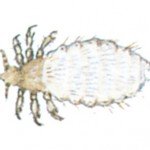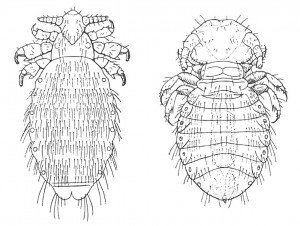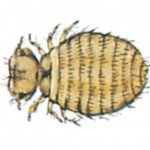
Dogs can have two different species of lice. One is a blood-sucking kind of louse, and the other is a biting kind of louse.

The sucking louse, linagnathus setosus, sucks blood like the lice found on people. It lives on dogs and foxes and never bites humans. This species of canine lice can grow to become 2 1/2 mm long. The nits are l mm long and are glued to single hairs or locks of hair. Its bite causes itching, small wounds and a reddish rash in the skin. The lice especially like the area around the eyes and ears and on the chest, back, flanks and around the tail. This canine louse is not very common in Denmark. If the dog has this louse, it often also has the biting louse at the same time.
The other species of canine lice, the biting lice, Trichodectes canis, are more common than the sucking lice. It is not a bloodsucker; however, it still drinks blood. It bites a hole on the skin and drinks blood from the wound. The dog’s biting lice are up to 1.7 mm long and have a large, rounded head. They live on the head, neck and ears of the dog. With well-groomed, well-nourished dogs, this species of canine lice is rare.
Common to the two types of canine lice is that both glue their nits onto the hair close to the skin. There are three stages of nymphs as well as both female and male lice. The nits hatch after about a week but the nymph stages lasts longer than with human lice – 2-4 weeks. The total development time from nit to nit is then 3-5 weeks. You may suspect canine lice when the dog scratches itself more than usual. If this is the case examine the fur for lice and nits.

Control
To eradicate lice from dogs, apply an insecticide throughout the fur. You only need two treatments a few days apart using treatments for fleas, ticks, lice, etc.




